Float Fishing With Flies: How Expert Guide Do It
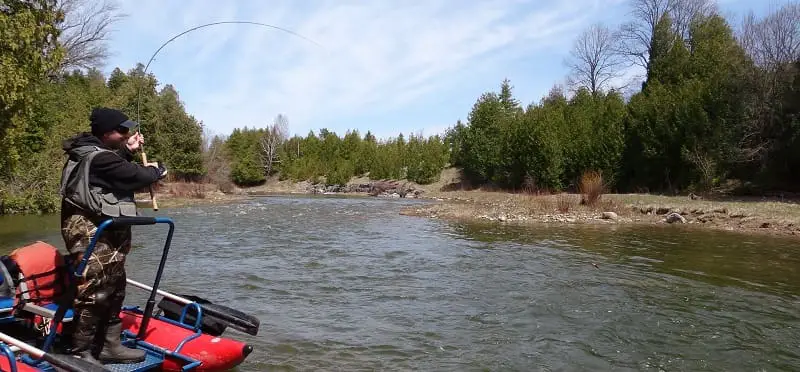
There are times when flies are the best bait for trout, steelhead, or salmon fishing in rivers. As a river fishing guide, I know it’s these are times when float fishing with flies will put more fish in the net for my clients.
Float fishing with flies is when you drift flies under a float or bobber on a specially constructed leader. If you have the right leader set up and you know how to get the best presentation with a fly under a float, it can be a deadly tactic for trout, steelhead, and even salmon in a river.
I will cover the types of floats, my four proven effective leaders, and the best flies to use.
When Should You Float Fish?
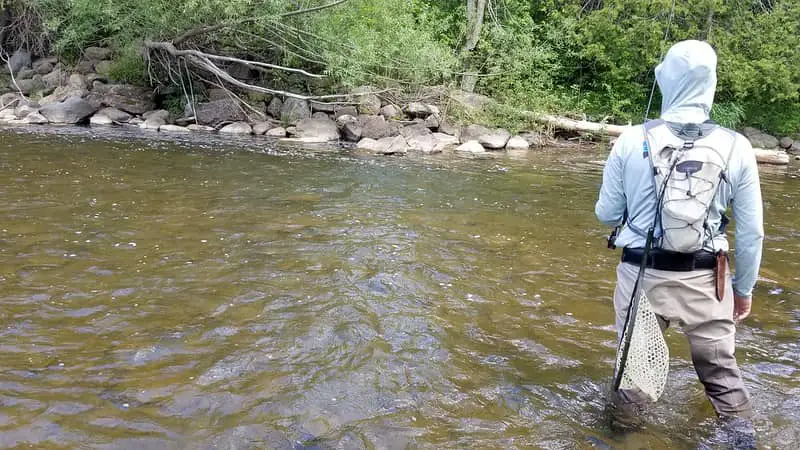
The best time to float fish is when you are in spots in the river that are three feet deep or deeper, which includes pools or runs.
When I get to a shallower spot less than three feet deep, I risk the fish seeing the float or the weights and getting spooked. I also risk my flies getting stuck on the bottom too much, so I don’t float fish in shallow water.
In spots that are less than three feet deep, I will often switch to a method known as Bottom Bouncing, and I will use my advanced bottom bouncing technique, which is exceptionally effective in shallow water and pocket water.
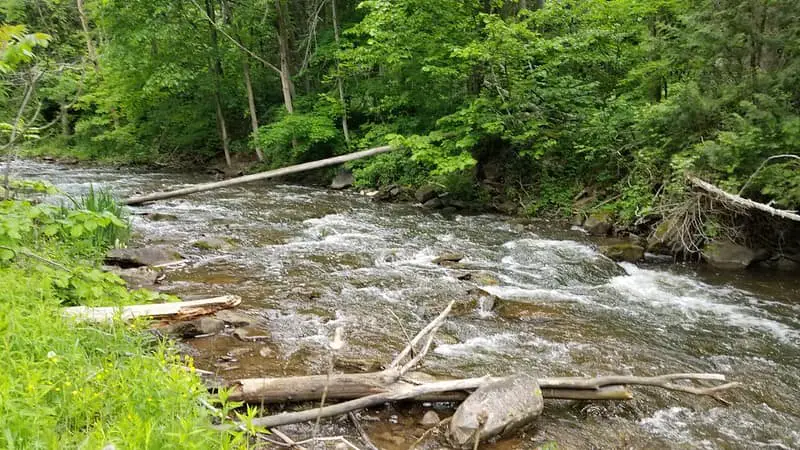
Float Fishing With Flies Using A Spinning Reel
You can float fish using spinning gear and the main advantage is spinning reels are easy to cast.
Some spinning reels allow the line to come off the reel more easily, some will hold more lines for those big long drifts, and some will have a better, smoother drag system. To see which reels I use and recommend, go to my page 4 Best Spinning Reels For Float Fishing.
Float Fishing Using Flies Using A Centerpin Reel
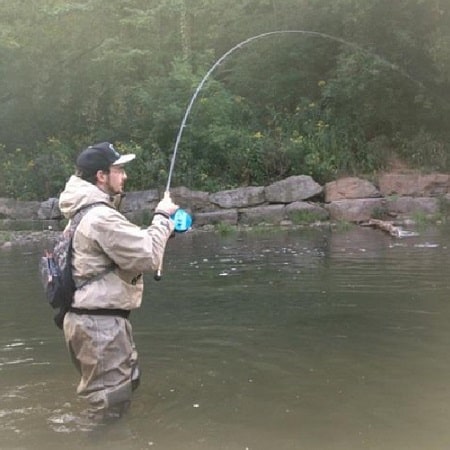
Centerpin reels were made to float fish! The honest truth is that there is no better reel for float fishing.
The Centerpin reel allows anglers to make long, smooth, and controlled drifts, which greatly improves their presentation. That means more fish in the net.
If you are unsure what Centerpin fishing is, check out my page Centerpin Fishing For Beginners – 20 Steps.
Best Rods
I always prefer longer rods of 8 to 12 feet long. Even when I’m fishing on smaller rivers that are only 10 feet wide I still like rods from 8 to 10 feet long.
The longer rods allow me to float fish better because the longer rod keeps the line up and off the water, providing more float control and a better hook set.
The longer rods will also protect the light leaders, which are often required when fishing trout and steelhead.
Best Line
My favorite line to use when float fishing is a monofilament line that floats. Not all mono lines are buoyant, and not all are good for float fishing.
Buoyant fishing lines can be mended or managed better, and that means a better presentation and a better hook set. Some braided lines are also very good.
I discuss the best lines for float fishing on my page 5 Best Float Fishing Lines For 2021.
Best Floats To Use With Flies
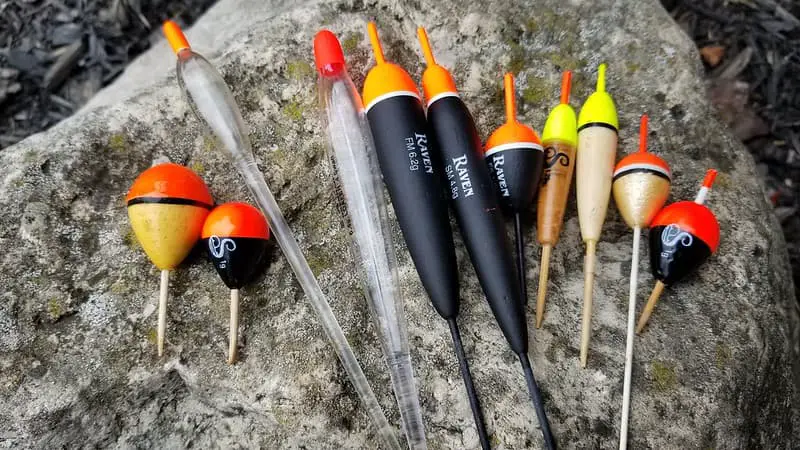
When it comes to river fishing, we call them floats, not bobbers.
The floats I use are longer ,thinner and are sensitive. A good float will do more than just detect a bite.
You can use the float to help you detect the bottom and to help you control the speed of the bait which will improve your hookups. The right float will also tell you if you are dragging bottom, or tell you if your flies are upriver or downriver.
Flies that are upriver of the float are dragging, and that’s a bad thing. Flies that are slightly downriver are good, but flies that are too far down the river are also bad.
I teach my clients to use the right floats and how to use them effectively to get a better presentation, and I guarantee the result is more big fish in the net.
I use different floats in different types of water. In shallow and clear water, I use the Drennan Loafer float, and in medium, to deep water, I use the Raven FM float.
I discuss the best floats for float fishing on my page 5 Best Centerpin Floats For 2021
The 2 Best Leader Setups To Float Fish With Flies
I use three leader setups. Setting up your leader properly will help you catch more trout.
These three leader setups are all you will need for any type of water.
The Shallow Water Setup
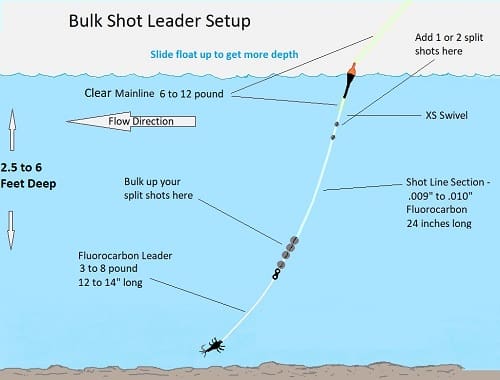
To float fish with flies in shallow water that is between 2.5 and 4 feet deep I use this leader setup.
You simply slide the float up and down the line as needed.
I also use the clear Drennan Loafer floats if the water is shallow and clear, so I’m less likely to spook the fish.
Medium to Deep Water Float Setup
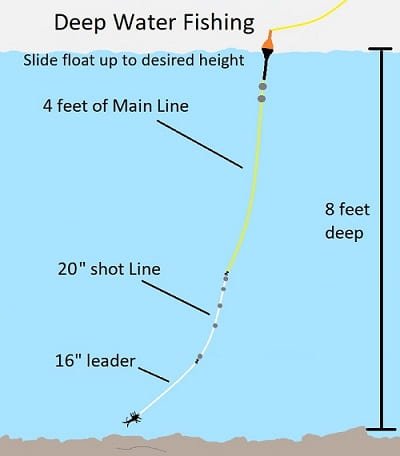
These are two deepwater rigs that I use up to 12 feet deep.
I will use the first leader in water as shallow as 4 feet deep simply by sliding the two weights and the float down to the swivel. If it gets deeper, I slide the float and the two splits up to the desired depth that keeps my fly 5 to 12 inches off the bottom.
This is the rig that I use the most for steelhead and in trout water that is not super clear.
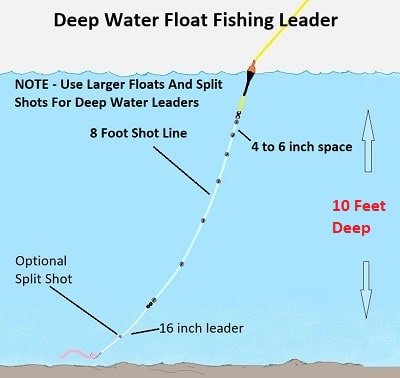
The second setup is for fishing the river where most or all spots are 8 feet to 16 feet deep.
I can adjust the shot line length to accommodate shallow water.
If the water is deeper than my rod is long, it’s very difficult to cast. I will change to a slip float in very deep water.
2 Fly Float Setup
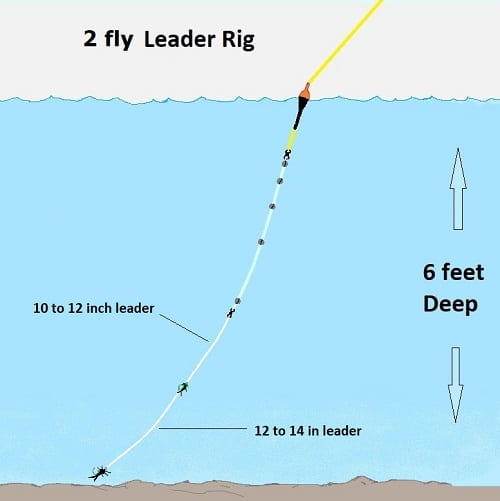
In my area, we are allowed to run up to three flies, so when I am float fishing nymphs, I usually run this two-fly setup.
Having two flies allows you to cover different depths, which helps you determine if the fish are all feeding low or if they are feeding high.
Running two flies also means experimenting with flies and seeing which ones the fish want the most.
Bottom Bouncing Float Rig
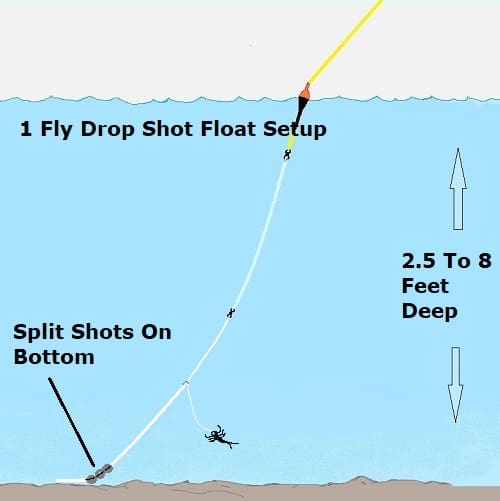
This unique rig works well in shallow to deep water when float fishing nymphs.
With this rig, all the weights are on the bottom and below the fly, and the flies are always up and off the bottom and in the strike zone.
Recent studies indicate that trout only feed off the bottom 13% of the time, so it’s much more effective to keep your fly off the bottom.
I tell my clients that it’s better to be 12 inches off the bottom than 1 inch under the trout’s head.
The weights are on what I call the tagline, and you can run a short tagline and have the fly closer to the bottom, or you can run a long tagline and have the fly further up the line.
I will also hang a second fly up the line off of the swivel.
With this rig, you may lose a few more weights but I rarely lose any flies.
Best Flies Float Fish With
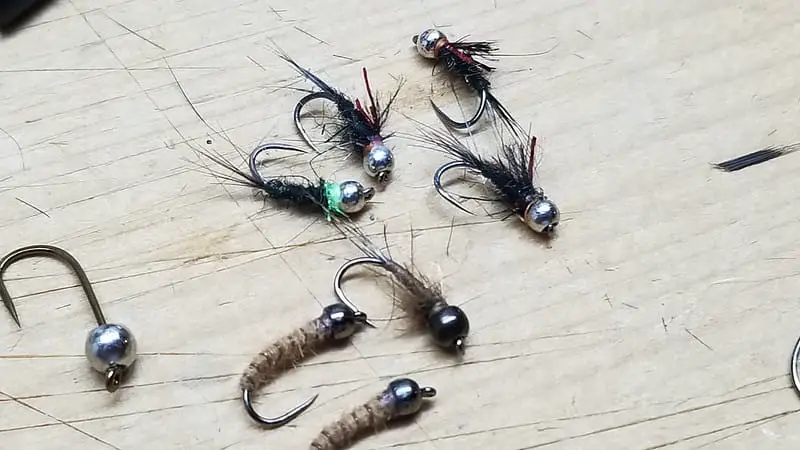
I love to use flies known as nymphs as well as egg flies and small streamer flies like Woolly Buggers and Clousers. Micro Woolly buggers can be fantastic.
Some of my favorite patterns are:
- Frenchie
- SOS Fly
- Polish Pheasant Tail Nymph
- Surveyor
- Pheasant tail and bead-head pheasant tail nymph
- Rainbow Warrior
Also, check out these great flies from The Fly Fiend:
- Glassy Peacock Nymph
- Sexy Walts Worm
- Hot Tag Hares Ear
- The Bio Biot
- Ice Dub Pheasant tail
- D-Rib Stonefly
- Polo Club Pheasant Tail
- The Last Tag Nymph
- Flash Back Quill Baetis
- Olive Wired Soft Hackle
- Diamond Braid Biot Emerger
- Surveyor Scud
- UVP Nymph
Tight Lines,
Graham

Great information!
I am fishing the Trinity River in Northern California for steelhead. I am using a 13ft redline with an Okuma centerpin. I have noticed a stonefly hatch (salmon fly to be exact) not yet adults, I believe the term Naiad is its phase. They are about 2″ long. And are everywhere. What is the fly you’d use this size and how would you fish it? Just like a wet fly? Is there some way to use a dry fly with the centerpin set up?
Thanks for your help.
Hi Nik,
If the steelhead are coming to the surface for flies, you could use an 8 or 9 weight fly rod and a floating line for this. Just drift the dry fly pattern along the surface. You could also nymph below an indicator, or you could use a wet fly swing with a similar-looking fly pattern. I would like try all 3 methods and see which worked best.
It’s not ideal, but I don’t see what you could not use a float and a dry fly if you really had no other option. juts cast the float out with 3 to 6 feet of leader below the float and let the float and fly drift along the surface. You could also present the fly below the float since it’s likely the steelhead are eating 90% below the surface even if you see them rising for flies.
Good Luck,
Graham
Good Morning!. Been doing well fishing the Lake Erie tribs this winter. Just a hobby after my retirement that has really taken off. I received a new 7wt set up for this Xmas and am chomping at the bit to try it out. Upon walking the creek yesterday, I noticed many fish in 1-2’ of water. What would be a good terminal starting point considering the conditions? Thank You very much’
I pretty much have the center pin understood and need info as to leaders, tippet etc.methods……
Hi Gregg,
In one to two feet of water i would say fly fishing with an indicator, or Euro nymphing would be the best method.
See these two article and let me know if you have any questions.
Fly Fishing For Steelhead
Euro Nymphing For Steelhead
Good Luck
Graham
This website is like the bible for fishing thank you graham it has helped me go from no fish to my best years yet.
Hey Rob,
Happy to hear.
Best of luck,
Graham
Thank you for this information. I’m going to the Methow river in Washington . Do you have any suggestions on using a center pin float fishing rod using flies? I have never fished the Methow. Thanks
Ron
Hey Ron,
In the past, the Methow river has one of the highest return rates of wild steelhead in Washington state but things have changed so special fishing regulations on steelhead now apply and they can change from year to year. Hopefully, it will be back to normal regulations and good fishing with the recent stocking efforts.
You could try the stretch from Lower Burma Road to Gold Creek, but again check the regs.
If fishing is permitted, Egg sacs, skein, and your typical nymph patterns will all work under a float.
Many of the same flies I recommend on my page best flies for steelhead will work on the Methow River steelhead. Try Wooly buggers, egg sucking leaches, zonkers, mayfly and stonefly imitations, worm patterns, and egg patterns.
Best of luck,
Graham
The same question as Ron’s, but the location would be in small rivers in Ontario Canada. The same flies as you suggested would work too? The places I go to are usually pressured and everyone is using mostly spawn sacks.
Hey Jaegger,
Absolutely, those same flies will work in all Ontario streams. Add a prince nymph which can be excellent in the spring.
How about a hybrid system using center pin reel with 10′ – 11′ euro nymph fly rod for euro nymph fly fishing. Center pin has better control of line.
Hi Mark,
I discuss using my Centerpin reel on my 10 foot 4 weight Euro fly rods on my article float fishing for trout. It works great for me, and if you prefer the certerpin, which I do, then absolutely you should use it.
Best of Luck,
Graham
Can you explain your line control technique when Euro nymphing/Advanced bottom bouncing? Are you hand stripping in the line or just casting it off the center pin reel?
Thanks.
Very informative sight!
Hi Richard,
When using a Centerpin reel, as the bait drifts towards me, I’ll reel in the line with the reel at a slow steady retrieve to maintain controlled tension without pulling the line or bait. And then cast it back out using a side cast or Wallace cast.
Good Luck,
Graham
Hey Graham, really enjoyed reading your articles. I live in West Virginia and I am going to try and make a trip this year to try to fish for the salmon and trout. I have no knowledge about it at all, so your articles have been amazing. Thanks! Would mid to late October be a good time to go?
Hey Chandler,
Being from WV I’m assuming you will be going to NY to fish for salmon. If you’re flexible with you’re schedule, I’d suggest going two or 3 days after large rains from late September to Mid-October. Some great runs can also occur in early/mid September after the rains. A lot has to do with the rains and water flow. Dry fall the salmon come up later, wet September and the salmon will be in early.
If you are planning a west coast trip that’s a whole other game which i’ll be covering in my west coast article series..
Good Luck
Graham